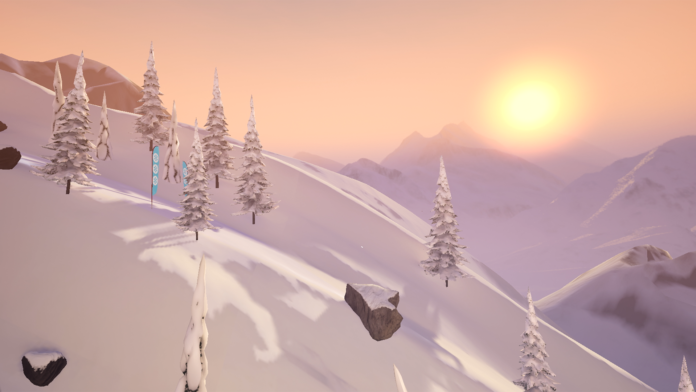Carve Snowboarding for the Oculus Quest represents virtual reality’s first depiction of this intense freeriding winter sport. However, whilst Chuhai Labs might be bringing something novel to the VR medium, they have a proven track record and pedigree when it comes to translating the sport of snowboarding to video games thanks to the involvement of lead programmer Giles Goddard. Goddard was the creator of the Nintendo 64 classic 1080° Snowboarding, and being a keen snowboarder himself, understands both the intricacies and subtleties of the sport. Judging from the game’s style and lingo, Chuhai Labs has been keen to capture the cultural feel of the snowboarding community as well.
It’s an alien world to me, I have no experience of ridin’ the powder or shredding the gnar, and I certainly don’t have much steez. But as a committed writer and reviewer, this novice gaper will endeavor to represent and do his best.
In a recent interview with Oculus, Goddard states that Carve has been carefully designed, much like its 1080° predecessor, to cater to all users having ‘a pick up and play arcade attitude with simulation level snow physics and handling’.
Oculus allowed me the opportunity to speak with Giles, and game producer Mark Lentz last month in the run-up to the game’s reveal at the Oculus Gaming Showcase, and they really sold me on the concept, leaving me feeling excited to try it out.
I was curious, as well as a little skeptical as to how a VR headset with no leg tracking could simulate you riding a snowboard, which I presumed would be mostly about legs. But it turns out, much of snowboarding is done with accurate positioning of the hands.
As Goddard describes ‘ In Carve Snowboarding you stand (or sit) sideways with your front foot and arm facing down the slope and your arms by your sides. Regular-stance players will have their left side towards the nose of the board, and goofy-stance players their right side. While holding the Touch controllers by your sides you can then rotate your body to change the direction of the board, just like in real snowboarding. You can grab any point on the board with either hand by using the grip button and perform spins to do over 100 different tricks, or even make up your own!’.
In practice, I felt this worked really well and it feels surprisingly authentic. The tutorial at the beginning is very basic, just a few pages of text, each with a simple instruction to repeat before progressing to the next. This is probably by design, as it puts you on the slopes within 60 seconds, with just enough instruction to figure out the rest as you play.
The video clip below shows me working through the tutorial at the start of the game and briefly exploring the cabin home location.
My first ride down the slope took 3 minutes 51 seconds to reach the finish line, as I crashed into almost every obstacle. Ten minutes and a couple of tries later I’d manage to get that down just over the qualifying target of 2 minutes 40 seconds, a rate of improvement that gave me encouragement that with a bit of practice I’ll get the hang of this. Subsequent attempts revealed this to be naive optimism on my part!
Compared to other sports-based titles I’ve played, like The Climb or Sports Scramble, I’d say the learning curve here is a lot steeper, although it might well come more naturally to others.
Either way, even with my stumbling, faltering efforts today, I can see that this game offers a lot of potential, and there’s some depth and subtleties to master. I’ve reached out to Chuhai labs today for the opportunity to discuss tips and tricks with them, as I’d love to put together a guide for this game, as much for my own benefit as our readers.
I was given access to the game only a day before release, and whilst that is often enough time to complete some Quest games, with this I’ve barely scratched the surface of what’s on offer. For $19.99 I think if you enjoy the concept there’s a lot of fun to be had, and enough complexity that sick skills can really be honed.
With the time caveat out the way let’s put this game through its fitness paces, but note that I may come back and update this later on, as I definitely intend to play some more.
This video shows one of my better rides down the slope, still not fast enough to unlock the next course! My time of around 2 mins 48 is almost a minute off the best target of 1:50 and even slower than the 2:40 minimum to qualify! This game is hard!
Preparation
First thing first, this is a true 360-degree game. There were multiple occasions when I lifted my headset and found I was facing in a completely different direction to where I thought I was. A couple of times I made contact with a wall, or my bookcase, although not in a hazardous way thankfully, no punches are being thrown after all. But you will definitely need a reasonably sized play area to get the most out of this game.
I used my Fitbit Charge 2 to record the workout and recorded a 30-minute play session. As a typical course run lasts two or three minutes, I essentially just kept repeating the race, so I probably completed around 10 runs in that time. A headband was worn, and I used a VRCover replacement interface and foam pad, to better sweat-protect the headset, and allow for easier cleaning afterward.
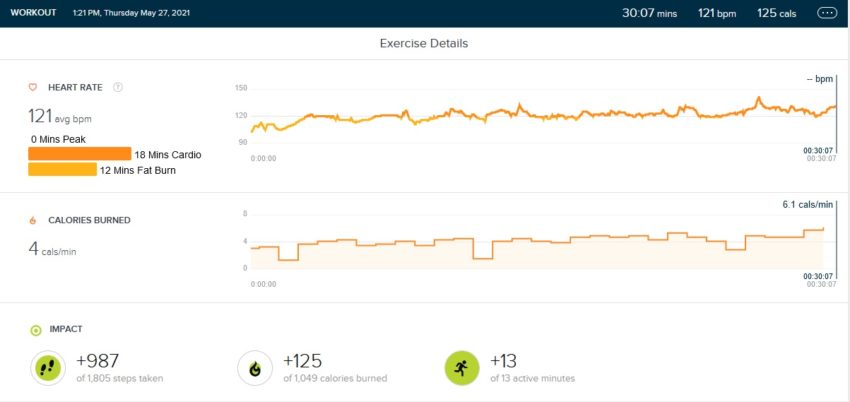
- Calories burned: 125
- Calories per minute: 4
- Average heart rate: 121
- Max heart rate: 141
- Steps:987
- Active Minutes: 30, 18 Mins Cardio, 12 Mins Fat Burn
Intensity 7/10, 8/10 If You Leap
Overall, I’d say this game is moderately active, although more so if you have enough space and will to physically jump in time to your in-game jumps. You’ll land a lot more quickly in real life of course, and jumping with a headset on can feel a little disorientating at first, but I enjoyed doing it. The game is more about achieving an accurate body positioning than flailing limbs about, so it won’t reach the intensity of something like FitXR or Beat Saber, but if you really immerse yourself into the experience, crouching over a virtual skateboard, leaning in and throwing yourself in the air to perform tricks and jumps will definitely get you heart rate up and work your entire body.
Arms 7/10
Carve Snowboarding utilizes your arms in a different way to most VR fitness-based games. There’s no slicing blocks or punching here so it’s a lower intensity workout in that sense. But deft maneuvering of your arms and accurate hand positioning is key to achieving mastery of the slopes, and therefore they are constantly being engaged. I felt it in my shoulders after thirty minutes or so. Switching stances as you ride the slopes also feels like an inherently satisfying movement to perform. Much like slicing blocks in Beat Saber, it made me feel considerably cooler playing it inside the headset than I surely looked in reality, and therefore encouraged me to switch often, thus working both my arms and legs more.
Legs 8/10
If you elect to play this standing and assume a crouched stance you’ll soon feel the burn in your thighs. I was constantly switching from regular to goofy stances too and would mirror my in-game jumps by physically jumping in my playspace. This was actually a lot of fun although obviously, I took a lot longer to land in the game than in real life. If you are going to jump physically, make sure your headset is on securely! I definitely got a burn in my quad muscles from the sustained tension of the crouch. Switching from this isometric style of muscle exercise to isotonic, explosive jumps and hops served to work the leg muscles both ways and provided an effective full leg workout.
Core and Balance 9/10
This game is all about balance and coordination! Leaning into turns and away to avoid obstacles will engage all of your core muscles. I’m quite susceptible to lower back pain, and I certainly felt a bit here about fifteen minutes in, which I think was a result of me leaning a bit too far forward. Strangely, it was less of a problem on my second play session later in the day, maybe as I’ve naturally adjusted my positioning to compensate. My abdominals and obliques felt fully engaged throughout the experience. To be successful the game demands fine movements and body adjustments to successfully traverse the mountain slopes, meaning your muscles have a major role to play.
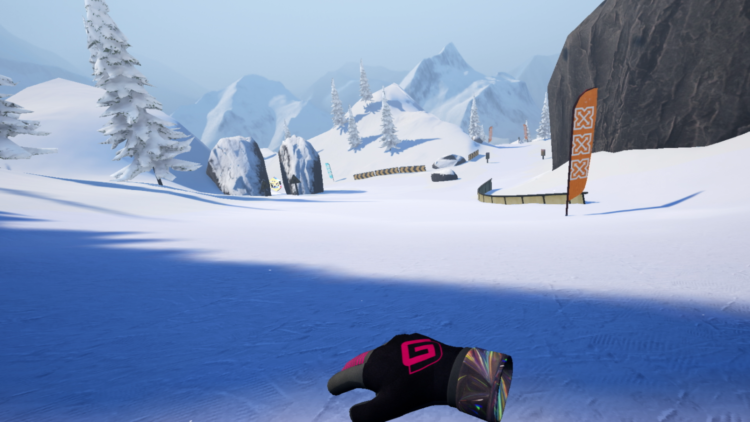
Time Perception 9/10
I found this experience really enjoyable, if a bit stop-start, as my inexperience lead to frequent wipeouts which can become a little frustrating. The occasional moments where I rode a rail successfully or stomped a landing were exhilarating, however, urging me to press on and try again. I actually had to repeat my 30 minutes playtest because the first time I got so absorbed in what I was doing I stopped to examine my newly acquired snowboards and their characteristics, as different boards perform better on different snow and surface types. I actually forgot I was doing a playtest and then saw 40 minutes had passed, meaning I had to repeat the test again.
Replayability 9/10
On the surface, it seems there isn’t much content. Just 6 courses, and two modes, time trials and freestyle, where you can perform tricks. However, replayability comes with learning the experience itself. It takes time to master the board’s handling. There is an option in the menu to turn on ‘full edge control’, enabling finer control over the board’s tilt. The game’s physics are realistically modeled and it will take practice, and time to get good, although I expect, much like Beat Saber, naturally coordinated users will pick it up much more quickly than I have. Whilst I think many users will buy this and enjoy it for a few hours, I think there will be a subsection of players who really enjoy perfecting their skills and improving their times and they will find hours’ worth of content here.
In addition to the inherent satisfaction that comes from the feeling of self-improvement at learning a skill, the game also features unlockable snowboards, along with discoverable music, in the form of cassette tapes scattered across the mountain slopes.
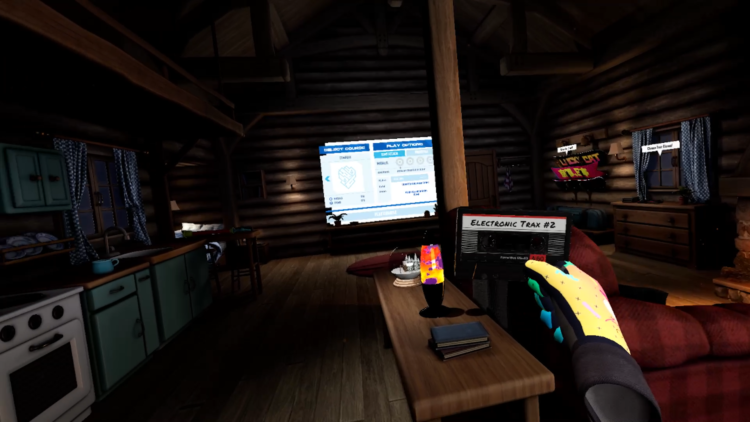
Fitness Scalability 8/10
Credit to Chuhai labs they have worked hard to make the game accessible to all, even making it playable in seated mode. You certainly don’t have to physically jump and crouch the way I did and you can definitely make it an easier experience, but for those wanting to make it more of a workout by jumping and playing as actively that is possible too.
Lack of Nausea 7/10
Now obviously a VR game that simulates you hurtling at speed down a mountainside is likely to be on the intense side, and therefore for newcomers to VR, you might want to acquaint yourself with gentler VR experiences first and get your VR legs before jumping into this. That said, I never felt any nausea and I had all comfort options turned off. If you are susceptible Chuhai labs have some comfort options to reduce the feeling of motion sickness, including a snow tunnel effect, where the faster you go the more your peripheral vision becomes snow-filled, focusing your view on the center. For the hardcore who hate comfort options and think they are for wimps and noobs, relax you can turn those features off!
Social Competition 7/10
The game has a global leaderboard and an asynchronous multiplayer mode, much like The Climb, where you can race against previous times, and a ghost version of either your own best time or that of friends and other users. It does provide some element of competition of course, but if this game has any future updates, a real-time multiplayer option would be top of my list of wanted features. Live racing friends down the mountain slopes would be a huge amount of fun and it’s a shame it’s not present yet.
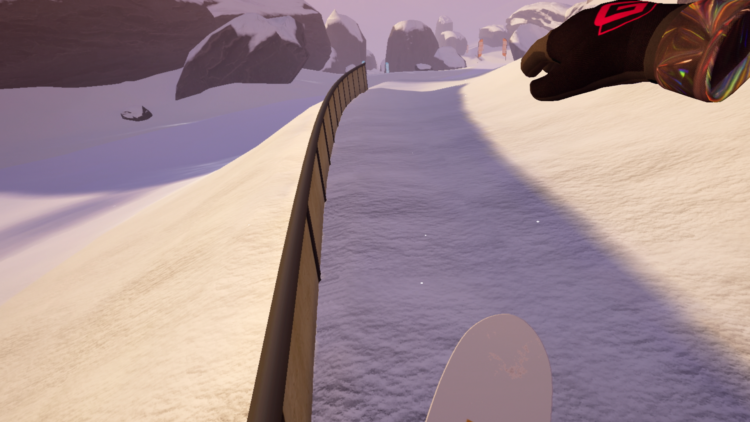
VRFI Fit Score 8/10
Carve Snowboarding fills an important gap so far in the Quest’s library. A winter extreme sports title offers something not previously seen in virtual reality. It’s similar in structure to that other popular extreme sports title The Climb, sharing features such as having unlockable accessories, hidden Easter eggs, asynchronous multiplayer mode, and the courses themselves, just like The Climb has multiple pathways through them.
But whereas the Climb and Climb 2 have more levels, Carve feels to have more depth of playability. With The Climb games, it doesn’t take that long to master the core gameplay, whereas here, there’s lots of nuance and skill required to achieve board mastery, and I think for those, who really enjoy snowboarding this will be a title to sink some hours into and return to again and again. At $19.99 I think this is a good buy for those who value gameplay depth over the number of levels offered. If you’re the kind of player who just wants to race through and complete levels and then on to the next game, this will likely be a short experience of a few hours. But if you’re somebody who enjoys the subtleties of learning and perfecting something you’ll have fun replaying the levels over and over.
As a fitness title, it offers an enjoyable way to get active and improve your balance and coordination, whilst providing an excellent leg workout should be willing to jump about a bit.
The Good
The gameplay is smooth and glitch-free.
The snowboarding experience feels authentic and realistic considering the limitations of the medium.
There is depth and subtlety to the gameplay which will reward players willing to put the time in to learn its intricacies.
Riding rails and pulling off successful tricks is exhilarating.
Excellent game for building core stability and improving your balance.
The Bad
The lack of a real-time multiplayer mode is a bit disappointing.
The game’s resolution is a bit low for Quest 2, with some noticeable aliasing. It looks like a Quest 1 game in that regard. Hopefully, the developers will enable a higher resolution mode for Quest 2 shortly, as has happened with many games on the Quest store.
A large playspace is required for full enjoyment and immersion.
Carve Snowboarding is available now for the Oculus Quest, priced at $19.99

